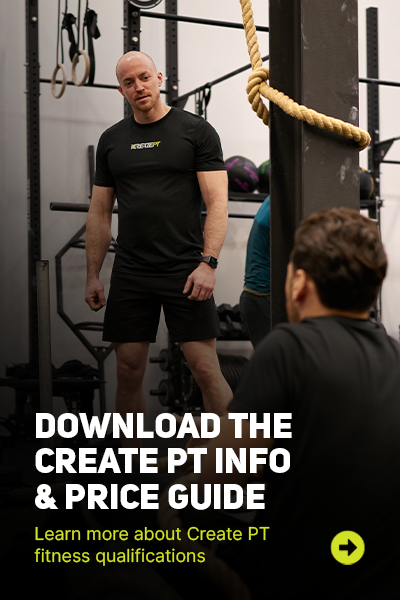Why is “Why” so Important for Personal Trainers?
As a personal trainer your main purpose is to help your clients get results. There may be some variations to this, with your own personal goals as a PT being more financially driven, or lifestyle driven, but ultimately if you can get your clients the results they want, you’ll do well as a personal trainer.
There are many ways to do this, different training approaches, intensities, progressive overload, diets, etc. but whatever your methods, you first need to understand what “getting results” looks like to your client.
There are a few main categories that most superficial goals will fall into; lose weight/tone up, gain muscle/strength, train for an event eg. Marathon and maintain health. Although these categories are very broad, they tend to be where most peoples initial motivation to go to a PT comes from.
As a personal trainer you’ve learnt from your PT course how to conduct a consultation, asking all the usual questions to find out about their training history, their routine and most importantly their goals. The mistake most people make is they stop asking about their clients’ goals when they get the first answer.
You get “I want to lose weight” as their goal then you help formulate that into a SMART goal such as “I want to lose 5kg in the next 3 months”. Yes it’s specific, measurable, achievable, realistic and time-bound, but it doesn’t address the most important question…WHY?.
Understanding why they want to lose 5kg in the next 3 months is what will help you keep them motivated. When they inevitably hit a plateau for a week or 2, it’s the why that will keep them going. When they have the choice of snoozing the alarm or getting up to go to the gym before work it’s the why that will get them out of bed. When choosing between the the home cooked meal or the takeaway it’s the why that will persuade them to put their apron on.
When we talk about understanding a clients’ why, we mean their intrinsic motivations. The deeper reason behind their goals. It is unlikely they want to lose 5kg just for the sake of it, there is likely a deeper more important reason behind it.
How to Find Your Clients’ “Why”
To understand the reasons behind your clients’ goals you need to ask the right questions. There are a number of ways to achieve this, but the most simple is to just keep asking why until you get to the answer. You don’t need to word it quite as simply as a 5 year old asking why over and over again, but it’s not far off.
As a rule of thumb, asking why 3 times will get you to a pretty deep rooted motivation behind their goals. We call it the 3 deep method. Your first question uncovers that they want to lose weight, your second question uncovers that they want to lose weight because they feel happier when they’re a bit lighter, your third attempt reveals that when they were a size 10 they felt happier because they were more confident wearing the clothes they liked and felt more attractive.
Now you have an emotional reason behind their weight loss goals. You know that the thing driving them to lose weight is not the number on the scales, but the feeling of confidence when they wore certain clothing.
Here’s an example of how you could do it without sounding like a 5 year old…
Personal trainer: So, your main aim is to lose some weight by summer, let’s make that a bit more specific, do you know how much weight would you like to lose?
Client: I think around 5kg would be ideal.
Personal trainer: Ok great, that’s definitely a realistic amount of weight to lose in that time frame, just under 0.5kg per week. Could I ask why you chose 5kg as the amount you’d like to lose?
Client: I don’t know really, I just feel crap at my current weight and don’t like how I look.
Personal trainer: Sorry to hear that, can you think back to a time when you felt better about yourself?
Client: Yes actually! Here’s a picture from a friends wedding a couple of years ago, I love this dress but it doesn’t fit me anymore, I was really happy with how I looked then.
Personal trainer: Great, so if we could get you back into that dress by summer, would that feel like success to you?
Client: Definitely, I’d be super happy with that!
Here you can see that the first question uncovered that they want to lose around 5kg. The second revealed that she feels crap at her current weight and doesn’t like how she looks. You could stop here knowing that the weight loss goal is tied to feeling unhappy, as this is an intrinsic motivator. However, by going one deeper asking if she remembers what used to make her happy you now have a real tangible goal to work towards with an emotional attachment to a specific dress that she wore at her friends wedding.
We then finish by reframing their goal as a question to confirm what success would look like, by confirming this back to your client you’re reinforcing what would make them happy and giving them something meaningful to work towards.
Using Their “Why”
As a personal trainer, you can now use this information in a number of ways. Firstly it will help you to motivate your client, over the next 3 months you can use the SMART goal to measure progress, and you can use this emotional reason behind the goal to drive them towards achieving that goal.
Secondly it will help with their own self motivation, your client may be paying you for 1 hour per week of personal training, but outside that hour they have around 111 hours awake per week without you there to motivate them. Fitting in that extra walk or not eating the chocolate bar may be difficult decisions for them to make, but thinking back to how they felt when they wore that dress to that wedding may be just the motivation they need to make the right decisions.
Thirdly, the goal being something more personal and meaningful to your client will bring them a sense of achievement and satisfaction that they likely would not have felt by just hitting a number on the scales. This leads to increased enjoyment and fulfilment, and likely to them being happier with your service as a personal trainer.
Ultimately you’re not using their why in a manipulative way to make them stay with you as a personal trainer for longer. By understanding their intrinsic motivations, and helping them understand them, they’re more likely to achieve their goals, they’ll be happier and a byproduct of this is they’re more likely to stay with you for longer and recommend you to others.
So you’ll spend the same amount of time with them as you would have anyway, but by understanding what makes them tick, you’ll be able to do a better job with the time you have with them, and you’ll both be better off as a result!
Incorporating Their “Why” Into Your Service as a Personal Trainer
Now you know more about your clients’ motivation you can incorporate this into the service you offer them. Surface level goals will only give you enough information to form a surface level SMART goal, meaning you could be missing out on key information that could help you offer a better service, or just different ways to help them.
In the case of the above example, if you only had the top level SMART goal of losing 5kg over 3 months then the number on the scales would be the most important consideration. You would weigh your client at the outset, then periodically thereafter, for some people weekly weigh-ins are motivational, some people prefer to leave longer windows between weigh-ins, but however frequent, your only measure of success is the number on the scales.
If you’re doing weekly weigh-ins and they have a bad week and their weight stays the same or goes up this could de-motivate them. If you get to the end of the 3 months and they’ve only lost 4kg, is that a failure?
However, by understanding her why you have so much more to work with. You know that fitting into a specific dress is a key driver, which means that actual weight loss may not be the most important factor, but body composition could play a large part. By gaining muscle and losing fat she may not lose loads of weight overall but may prefer the way she looks.
You know that her happiness is linked to how she looks in certain clothing, not necessarily to the number on the scales. So now you can help her to feel more confident and happy with the way she looks through a combination of weight loss, body recomposition and psychological factors.
With this deeper goal, success at the end of 3 months may look different to just the number on the scales. Feeling happier and more confident may be enough to make her feel like she has achieved her goal even if the number on the scales hasn’t dropped by 5kg.
As her personal trainer you can then help to reframe the goals going forwards to give her something new to work towards. After 3 months training with you her goals may have shifted. Now the surface level goal may be “maintain my current weight & get a bit fitter”, when you dig deeper you find this is because she has more energy and feels generally happier, you dig deeper again and find out that now she feels more confident, she’s not bothered about weight loss anymore, instead she wants something to train towards and some of her colleagues are doing a Tough Mudder for charity in a few months.
You can see how this process of understanding their underlying motivations will help with more effective goal setting for your clients. Now reframing the goal for her would be something like: “So if you can keep up with your colleagues and complete all the obstacles at the Tough Mudder, would you be happy with that?”.
Upselling
As a personal trainer you may be in it to help others, enjoy your lifestyle or any number of reasons, but ultimately we all need to earn enough money, and who doesn’t want more money?!
In addition to changing your programming and keeping your clients more motivated, understanding their intrinsic motivations can help you offer different or more comprehensive services to your clients. As a personal trainer you know that you fill many roles, not just a rep counter but a counsellor, nutritionist and confidant.
You may be able to add so much value to your client just by texting them once a day to see if they’re on track with their nutrition, that’ll take about a minute a day and may be the difference between them sticking to their plan or not.
You could offer them the good old block of 10 PT sessions for £300 that they might use over 2 months, maybe longer, then you have to chase them again to buy another block.
Or knowing how much the daily text helps them, you could offer them a monthly service that includes a PT session a week and an accountability service whereby they send you a screenshot of their MyFitnessPal at the end of each day so they feel accountable to you and you give them a quick reply with some guidance or congratulations on a good day, and you charge £200 per month on a recurring direct debit.
This works out more expensive for them but provides a service that is super valuable to them and very low cost to you in terms of time, and the end result is likely better results for them and a more consistent income for you, win-win!
This is just one example of how you could use their “why” to upsell, we go into loads more detail in the full PT course. If you’d like help understanding more about effective consultations, goal setting and ultimately being a more successful personal trainer check out our personal training courses.







